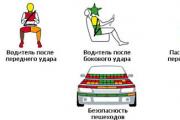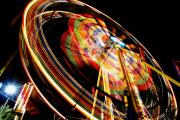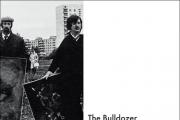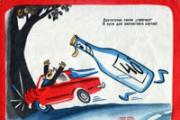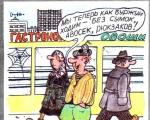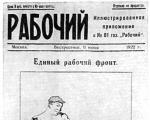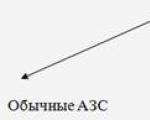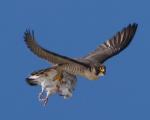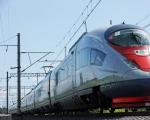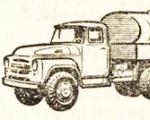Even in ancient times, people dreamed of taking to the air and learning to fly like birds. History has brought to us a lot of evidence of the attempts of various people to make wings and fly. So, in 1020, the English monk Aylmer of Malmesbury, inspired by the Greek myth of Icarus, made artificial wings and jumped off the tower of the local abbey. Having flown a short distance, upon landing, the monk broke his legs and wanted to repeat the flight by improving the design and adding a tail, but the abbot forbade him to do so. Most of the "inventors" ended up much worse - they were crushed to death. And yet - what is the history of aircraft and when did the first successful devices appear that allowed people to take to the air?
The history of flights begins in ancient China. Even in the 3-4 centuries BC. e. The Chinese invented the kite. Initially, this device was used to entertain the people at all kinds of holidays.
chinese dragon kite
However, kites soon found other uses. For example, fishermen began to use kites to catch fish by tying bait to them, kites were used to exchange signals over long distances, they even delivered messages and scattered leaflets with their help. Of course, the Chinese also had the idea that a large kite could lift a person into the air. Flying a kite was quite risky, but history has preserved evidence of successful flights. The first written mention of such a flight that has come down to us dates back to 559. This year, the cruel Emperor Qi Wenxuandi ordered large kites to be flown by his political opponents, who were condemned to death. One of them managed to fly several kilometers and land safely outside the city.
It is amazing that thousands of years passed before hang gliding, i.e., in fact, the same simple unpowered aircraft as the Chinese kite, became popular and spread. One of the enthusiasts of such flights was Otto Lilienthal, who made at the end of the 19th century. more than 2000 successful flights on gliders of our own design. He used the same materials as the Chinese - wooden rods and silk.


photo - flights of Lilienthal
Unfortunately, one of the flights ended in an accident - a gust of wind overturned the glider and Lilienthal fell, breaking his spine. “Sacrifices are inevitable,” he said about this. And the modern history of hang gliding began only in the 70s of the 20th century. The date of birth of the modern hang glider is 1971.
Before the advent of airplanes and helicopters, the easiest way to fly was to use lighter-than-air aircraft such as hot air balloons and airships. Interestingly, the story here again leads us to China. Probably as early as the 3rd c. BC e. Air lanterns were invented in China. This lantern is a simple rice paper construction with a small burner inside.

Chinese air lanterns
The Chinese used air lanterns in ceremonies and as a means of signaling. Thousands of years passed before people began to fly in balloons.
The inventors of the hot air balloon are the Montgolfier brothers from France. The brothers were guided by not entirely correct ideas - they came up with the idea to make an analogue of a cloud and place it in a bag so that it could lift this bag into the air. To this end, they filled their bowls with smoke from burning a mixture of straw and wet wool. However, their approach led to success. First, the brothers experimented with small balloons at home, and then arranged a large demonstration of a balloon for the residents of their city of Annone. This happened on June 4, 1783. Soon they learned about the balloon in Paris, and in the autumn of the same year the Montgolfier brothers launched their balloons already in Versailles. For the first time in a balloon, they decided to launch passengers - they were a sheep, a duck and a rooster. Finally, making sure that a balloon flight would not harm a person, on October 19, 1783, the first balloon flight was made by people.

first balloon flight
Balloons had a significant drawback - their flight depended on the direction of the wind, therefore, during the 19th century. attempts to create a controlled aircraft with an engine did not stop. We tried both options with installing an engine on a balloon, and with installing an engine on a glider. But despite the fact that the idea of controlled flight was expressed shortly after the flight of the first balloon, it took more than a hundred years before controlled flight became a reality. It wasn't until 1884 that Frenchmen Charles Renard and Arthur Krebs were able to build an airship capable of moving freely in any direction. Their airship had an elongated shape and was equipped with an electric motor that ran on batteries.

airship Renard and Krebs
Attempts to put an engine on a glider and thus invent an airplane did not lead to much success for a long time. Among such attempts was, for example, Mozhaisky's plane. Mozhaisky, rear admiral of the Russian fleet, began to invent the aircraft as early as the 50s of the 19th century. Starting with gliders that lifted harnessed horses into the air, Mozhaisky moved on to designing an aircraft with an engine. Unfortunately, the steam engines with which he tried to equip the aircraft were too heavy to keep it in the air, although there is evidence that Mozhaisky's aircraft was able to take off for a short time.

Mozhaisky plane (model)
Mozhaisky spent all his money on inventive activity, sold the estate and eventually died of an illness in poverty. The then Russian officials were not interested in the ideas of Mozhaisky and did not finance his work, as a result, the American Wright brothers became the generally recognized inventors of the aircraft. They made their first confirmed flight in 1903, 13 years after Mozhaisky's death.
The first documented flight of an aircraft designed by the Wright brothers took place on December 17, 1903. At the same time, the aircraft was launched using a rail catapult, and the distance it flew was only 30 meters.

first flight of the Wright brothers
The Wright brothers invented not only the aircraft itself, but also a light gasoline engine for it, which became a real breakthrough in aircraft construction. Nevertheless, time has passed from the first flight to the active development of aviation. The following year, the Wright brothers, in the presence of journalists, could not repeat their success, the plane went to the hangar, and the inventors began to design a new, more advanced model. The US military was in no hurry to conclude a contract with the Wright brothers, doubting the ability of bicycle mechanics (this was the specialty of the inventors) to design something worthwhile. In Europe, reports about the flights of the Wright brothers were generally considered a lie. Only in 1908, after impressive demonstration flights by inventors both in the US and in Europe, opinion changed, and the Wright brothers became not only famous, but also rich.
In 1909, the Russian government finally realized the importance of inventions in the field of aviation. It refused to buy the Wright brothers' aircraft and decided to build its own aircraft. The first Russian airplane was built and flown in 1910 by Professor Alexander Kudashev.
Man has always dreamed of flying, but at the same time he understood that he would not be able to do it like a bird, therefore an aircraft was needed. And so a few smart and courageous inventors in the 19th century approached their goal. History has preserved several names of such experimenters who tried to build the world's first aircraft. Most countries recognized the primacy in the invention of the aircraft for the Wright brothers. How it was, we will describe in this article, as well as talk about other scientists who invented the first aircraft.
Aircraft Mozhaisky
The Wright brothers Wilber and Orville named their first airplane Flyer 1. They designed it with an internal combustion engine of their own design and carried out its test, its first flight in 1903. That car had some small achievements, the plane just rose one and a half meters and flew 37 meters, but it was proved that flights are possible.
The experiment was a success (it happened on December 17, 1903) despite the fact that there was a strong wind, the apparatus slid along the guide rail and was controlled in acceleration by a primitive catapult.
The Wright brothers strengthened their faith in building an airplane and continued to work, calculate and refine their car. In October 1905, another test of the aircraft was carried out, which was given the name "Flyer-3". This plane flew as much as 39.5 km in 40 minutes. The airplane was flown by Wilber. It was his last and longest flight. The brothers had eyewitnesses to their flight, including among their friends and local farmers.
Local journalists missed this historical moment, and now no one can say for sure in what year the first aircraft was built. There are also few photographs, although the Wright brothers did make some of them. The most important thing that they realized after the last flight is that they have built an aircraft that is completely controllable in flight and can land.

Glider 1900. There are no photos with the pilot
It was the idea of controlling an aircraft, put into practice, that made possible the further development of aircraft construction. Therefore, the Rhine brothers are given primacy in this invention.
However, it would be unfair not to mention other contenders for the invention of the world's first aircraft.

Orville in Kitty Hawk with a 1901 glider, nose up; he didn't have a tail
Alberto Santos-Dumont
The dispute about the primacy of the invention is between Alberto and the Wright brothers. In Brazil, it is he who is considered the inventor of the aircraft.
Alberto Santos-Dumont - the inventor of balloons, airships, he was engaged in the possibility of controlling these devices. Having taken up devices heavier than air and understanding their future, in 1905 he completed work on one of his projects. In October 1906, he tested his experimental aircraft, called the 14-bis. The device flew at a height of 2-3 meters, a distance of 60 meters, there were many witnesses. He took to the air in calm, calm weather with the help of only his engine.

Santos-Dumont did not stop there, and his next project was the Demoiselle monoplane. The device had a length of 8 meters, a wingspan of 5 meters, weighed 110 kg, easily overcame 200 meters at a speed of 100 km / h. The inventor constantly refined and improved his apparatus, periodically making flights on it. The last of his achievements were flights of 8 and 18 km in aircraft with two-cylinder engines.
Santos-Dumont made no secret of his inventions either, providing blueprints for young aspiring aviators in the Mechanics magazine. The experimenter rightly believed that aviation had a great future.
Now you know approximately at what time the first aircraft was built, but one cannot fail to mention the Russian inventor who also worked on the invention of the aircraft and did it two decades earlier than the Wright brothers
A.F. Mozhaisky - the inventor of the first aircraft
Alexander Fedorovich Mozhaisky proposed his ideas for building an aircraft, but in Russia he encountered bureaucracy, callousness, illiteracy and misunderstanding of officials. Due to extreme need, he could not complete the construction of his apparatus, but the authorities not only did not allocate money, but in every possible way prevented the construction of the apparatus. Alexander Fedorovich nevertheless managed to get part of the money allocated, partially covering the expenses from his savings and the sale of personal belongings. Mozhaisky even received a patent for the invention in 1881.
He completed the apparatus, and the flight took place, it was July 20, 1882. The result was modest: the plane accelerated along the wooden deck, took off and landed quite a bit after flying. The plane was controlled by his assistant, mechanic I.N. Golubev. The experiment was positive and proved that flights are possible. The apparatus was not perfect, and Mozhaisky understood this. He knew in which direction to work, but three years later the experimenter died. The authorities, however, tried to classify the invention of the Russian scientist and did everything to make it forgotten. The plane also did not survive, it was transported to the Mozhaisky estate, then, in 1896, it burned down.

Takeoff of the Mozhaisky plane (from a drawing by the famous pilot K. Artseulov)
The Russians rightly consider A.F. Mozhaisky as an aviation pioneer. The invaluable experience and achievements of the inventor were used by Russian designers in the construction of the aircraft "Russian Knight", "Ilya Muromets", "Svyatogor" in 1913-1915.
As you can see, it is impossible to specifically answer the question of who invented the first airplane. If you look, then aviation was born and developed thanks to the enthusiasm of many fanatics. All of them have the right to recognition. Finally, watch the 14-bis flight video of Alberto Santos-Dumont. Of course, this is not a real plane, but a copy of it.
In contact with
Some people don't fly planes just because they've never done it. This is not a fear of danger, not a fear of heights, but simply a panic in front of something unknown. And many do not understand what pleasure they are depriving themselves of, because flying is very pleasant and interesting, and most importantly - fast. And in many cases, this is the only way to get to the right place. Do not neglect technological progress, because horses and carriages, weeks and months of travel are already far in the past.
Personally, at first it was not the planes that scared me, but the airport. How to get into it, where to run, how not to confuse anything, and in general ... Let's imagine that you are at the airport for the first time. The procedure will be approximately the same, except that the inspection and passport control in some cases change places.
First time at the airport
What time do you need to arrive? Check-in for the flight starts two hours before departure. Why so early? You need to have time to go through a large number of procedures that require time. You can arrive even earlier just in case. But it is better not later, especially if you are flying for the first time.
entrance
In our country, unlike many others, anti-terrorist security has been strengthened. Therefore, try to plan the time that you will spend on ... to go inside the airport. Often there are queues. You will already be examined there and your things will be scanned, even if you just came as an escort. You can go back, but you can only get back to the airport through security again.
Scoreboard and registration area
The board of departure and arrival is, perhaps, the most romantic object at the airport, and even more than once sung. The board indicates the number, destination, time of departure of the flight. Be sure to check your flight number. Once we almost got confused with flights - which departed with a difference of 15 minutes.

Sometimes several flights can depart at the same time, keep an eye out too. Another confusion is that airlines often send codeshare flights. Do not be guided by the name of the airline, and even sometimes time is not an indicator. Direction and number are what you need to see. Also, the scoreboard indicates which check-in counter you need to go to and in what state the registration is: is it open or, God forbid, has ended. Check-in for the flight, as I said, starts 2 hours before departure and ends 40 minutes before it.
Preparing luggage
I did not find any useful information about the preparation of luggage on any "good" portal.

Usually, “smart” life hackers write about prohibited items and the weight of luggage somewhere in paragraphs about inspection, not taking into account the fact that we part with luggage much earlier, and this implies a completely different sequence of actions.
Baggage flies separately from you
You can fly without luggage, and put all things in your hand luggage, if the airline allows it. This is what I usually do, it significantly speeds up the parting with the airport upon arrival. In this case, your suitcase or backpack must fit certain dimensions and not exceed the weight limit.
Oversized and oversized baggage
Dimensional - suitable for standard sizes. Speaking in Russian, a standard suitcase or bag. Oversized is suitable for weight, but not for size, and is issued separately. By the way, oversized luggage is most often lost.

If you are concerned about this topic, then feel free to go to the airline's website and check what they can and cannot do. No other way. Because different airlines treat baggage differently. It is clear that items such as a guitar, a huge box or a plasma TV can hardly be called bulky luggage. You will not be asked for separate money for oversized baggage.
Extra bed
You can buy additional luggage space, it costs some money. But no one has canceled cheating, for example, the Aeroflot gold card allows you to carry two luggage for free at the same time, well, in principle, such a card is true and envy.
Package
Suitcases are usually thrown onto the plane in a rather barbaric way, so if you want to extend the life of your traveling friend, you can pack it for a fee. The luggage is wrapped with a special film by specially trained people in special places. Finding them is easy.

If you are carrying something valuable, it is advisable to wrap your luggage. At the airport, there are usually several packages with different prices. Naturally, the most expensive are located closest to the main entrance. You will be wrapped for about 700 rubles, or 10–15 EUR. In addition to official packers, there are also "spider-men" who will offer the same service 2-3 times cheaper. Wander around the airport for a while, looking meaningfully at the packing houses, and these enterprising sly ones will find you themselves.
overweight
If you have (horror!) an advantage, then prepare the money. Well, the time for registration of additional baggage and overweight will take from 20 to 40 minutes for sure.
Your baggage must pass in terms of dimensions and weight, as I said, allowable in a particular airline, and it is also advisable to put everything that cannot be taken on board, that is, liquids, aerosols, and sharp objects.
Feel yourself. Money, passport, other documents and a boarding pass must be literally glued to you. In no case do not leave money in your luggage (there are such cases), and without a passport you, in principle, will not fly far. It is best to store such necessary items in a small bag or pocket, in general, with you.
registration
You can check in for a flight from home in advance. This gives certain advantages. For example, you can choose the best seats on the plane.

Registration is elementary, Watson. When registering for a regular flight, they usually don’t ask for anything other than a passport: the employees already have all the data, because Big Brother has been watching you for a long time ... The only time the Spaniards asked for a printout of my e-ticket, because my name was not written in their database with that letter. But this is more the exception than the rule. At check-in, you temporarily say goodbye to your luggage. Luggage is put on the belt and weighed. After all this, you are issued a boarding pass indicating your gate (exit), your seat on the plane and a tag for baggage claim. Never lose your boarding pass. Now he is your king and god.
You may be asked what you take on the plane. The items you carry on board are referred to as carry-on baggage. Here is what should not be in hand luggage:
- Liquids. Some people think that you can’t carry anything liquid on board, but this is not so. Up to 100 milliliters of any liquid substance can be safely carried with you.
- Sharp, piercing and cutting objects. If you have scissors, corkscrews and knives in your hand luggage, then most likely you will be asked to part with them at the inspection. Learn about diabetics. Syringes are available. But in the presence of (quote) "certificate from a doctor in free form."
- Aerosols. All varnishes, sprays and sprays must fly in the luggage compartment.
Hand luggage can weigh up to 10 kilograms. The size requirements for all airlines are approximately the same. There are even special suitcases that fit the dimensions of hand luggage. In fact, if you're on a scheduled flight, you can carry just about anything on board. Once we were carrying a huge basket, a giant hoop the size of a hula hoop, and… straw sheaves. They were light, but voluminous, we could hardly see behind them. However, Aeroflot employees were loyal to the sheaves, even wishing us a good event.

In addition to a special suitcase, you can take a fairly large bag or backpack on board. Since we carry a lot of props on business trips, all personal items are usually placed in a small handbag.
Inspection
You can lose a lot of time during the inspection, as there will be people rushing not only to your flight. You take a special tray and put everything on it: hand luggage, things, gadgets, a laptop (in Europe they ask you to take it out of your bag and call it a laptop, for a minute!), all metal objects and shoes, if it is on thick soles or heels. Here it is easy to part with liquids or aerosols if their volume exceeds the norm. For example, you are trying to smuggle a liter of shampoo - most likely it will be confiscated. Creams, gels, toxic substances, sharp objects - tell them "adyos" if you haven't transferred them to your suitcase. So we parted ways with Enterosgel at Heathrow Airport, it was very strict there.

This whole story is connected, again, with anti-terrorist security, such rules were introduced in 2007. On board (again) - no more than 100 milliliters of liquid in total, that is, you can take with you a small cream, a cold spray, a perfume sampler and liquid for lenses, in general, a bunch of liquids, but the main thing is that they should not be in total more than a hundred ml. Yes, and it is desirable to forget about jokes about drugs and weapons. They don't understand jokes at the airport.
If you don’t want to waste a lot of time and make yourself nervous, as well as embarrass the aunts with sad faces and scanners in their hands, then in principle you should not hang on yourself all the iron jewelry left over from the gypsy grandmother, belts with massive buckles and put shoes on thick soles or heels: they will undress and undress as if there is nothing to do. And this, you see, is not the most pleasant procedure. By the way, here is a link to a wildly funny video, where a friend did not understand what they wanted from him, and scanned along with his luggage.
Passport control
Keep your passport and boarding pass with you, preferably in your hand. It is also better to avoid stupid jokes at passport control. Taking pictures of the passport control area is prohibited. Therefore, if something suddenly seemed funny to you (for example, your own face and you got drunk on yourself), you will be asked to delete the photos.

The official in the booth may ask questions. For example, about the purpose of the trip. Will leaf through your passport in search of visas and stamps. I was remarked several times that, they say, I don’t look at the border guard all the time, but pick my phone (it’s better not to be distracted from this important process by anything else), and about the fact that the passport was stained (yes, I once dropped it in Kuru in , and several seals blurred). Yes, you just might not like it. By the way, if you have a biometric passport or visa, you may be asked to put your finger on the infrared reader.
The waiting area
When re-reading my own text, I quickly replaced the word “desirable” with “mandatory”. You absolutely must immediately find your gate (exit). Sometimes it's not easy. Sometimes special trains run between gates, as in Madrid Barajas or London Heathrow. Sometimes they write terrible numbers: how long to go to the exits. Sometimes it is the number 15, that is, minutes. But exhale: this has never happened at Russian airports. Your ticket will show the exit number and the boarding time, i.e. the start time of boarding. It is better not to go far from sin away from the desired exit, otherwise you can miss important information. The exit may change, the flight may be delayed, but you never know what else. Control the situation.

There is usually something in the waiting area. For example, Duty Free. What is "Duty free" does not need to be explained to the Russian tourist, who usually begins to prepare for a vacation, drinking alcohol from this shiny, delicious smelling and shining market. The belief that it is cheaper in Duty Free is just a belief. For example, alcohol and snacks are often more expensive than in supermarkets, cigarettes are sold only in blocks, cosmetics correspond to the market value. However, what should not be doubted is the quality of the products. It is better to buy good perfume, professional cosmetics, gift packages of sweets in Duty Free. By the way, when buying, you will be asked to present your boarding card, so do not take it far away.

And, of course, there are all sorts of cafes in the waiting area. Unless you're in Berlin's Tegel, for example, which is more like an Ikea packing place. It's not a cheap pleasure to eat there, but I usually take water from the machine. The air in the plane is dry and you want to drink. Anything purchased in this area is eligible to be carried on board.
boarding the plane
Depending on the airport, your route from the gate to the board may be as follows:
- telescopic ladder,
- bus,
- on foot.
If the airport is small, then you can walk, usually a short distance. Buses sometimes have to wait, they are hot and crowded. Ideally, if you are walking along a telescopic ladder - this is such an air bridge from the airport to the plane.

If you have a lot of carry-on luggage, it is better to get in line at the gate early in order to have time to grab the luggage racks. Sometimes there may not be empty seats next to you, so you will have to look for an empty shelf away from your chair. In smart airports, there is a division into groups so that queues at the gate are not created. In this case, your group number is also indicated on the boarding pass. But personally, I like to wait until the last minute: I jump on the gate when the majority of people have already boarded the plane.
First time on a plane
And now you are so happy sitting on the plane and, perhaps, shaking with fear that this colossus is about to soar into the air. It won't happen instantly. For a while you will be packing. For some time the crew will be preparing. Then beautiful flight attendants will start showing you how and what to do in an emergency. At this time, the aircraft will begin to move towards the runway. Before, I always loved the moment of takeoff, when the iron bird accelerates so that it presses you into a chair, and then takes off from the ground, but now I often fall asleep even before takeoff. Most importantly, if you're scared, take a comfortable position. Good luck if you have a pillow under your head, because external comfort and internal comfort are inseparable.
Places
When it comes to seats inside an airplane, there is a simple law: the closer you are to your head, the less you will be shaken by turbulence. Turbulence, or turbulence, is the vibrations of an aircraft caused by the eddy currents of the wind, descending and outgoing. It's not scary. The usual turbulence that occurs when flying through some types of clouds is not dangerous in any way. The aircraft is designed to withstand the resulting overload. In general, when the plane shakes, this is not a technical breakdown, and the pilot has not gone crazy, this is just a temporary phenomenon that needs to be accepted and forgiven. And do not set yourself up for horror: I flew many times in such a way that I did not shake at all. Since there is less shaking at the beginning of the plane, the business class is located there.

As for "at the window or not at the window", here the moment is moot. If you have never flown before, then it may seem to you that a fascinating picture in the porthole is going on throughout the entire flight. However, it is not. The most interesting thing is takeoff and landing, when you see the city turned into a toy. And then the plane gains altitude and rises above the clouds. Behind the window there will be monotonous blinding white clouds if you fly during the day, or endless darkness if at night. If you are not a big fan of sticking your forehead into the wall and snoring, then there is no need for a window. There is nothing wrong with choosing an aisle seat - it is convenient to go to the toilet without stepping over sleeping neighbors.

Great if you are flying in a half-empty plane. After takeoff, when it is allowed to wander around the cabin, look into the tail section: there may be three free seats. I call it "platzkart". You can stretch out on them, cover yourself with a blanket and sleep. No one will say a bad word to you - it's checked.

A special chic at check-in is to get seats at the emergency exit. Ask, and they will give if they are still free. In most planes, the distance to the next seat is very far, and the table extends from the armrest. Of course, you will have a great responsibility - to save passengers in case of an emergency evacuation, since you will be the very first to exit there. But then you can stretch your legs and go crazy.
Food
It all depends, of course, on the airline and the features of the flight. If you have the option to check in in advance, you may also have been asked to select a menu. Major international airlines offer a special menu: kosher or vegetarian. I have not tried to order the menu in advance, but I know that this is possible.
I once took a vegetarian lunch aboard British Airways. The salad with quinoa, avocado and tofu was much tastier than the usual lunch, which included a stale bun with mayonnaise. However, in any case, do not expect culinary delights from the economy class. Unfortunately, I did not have a chance to fly in business class, but the insiders know that it is delicious there, especially if it is Aeroflot. Fortunately, the latter are tasty even in the economy, sometimes there was also a red fish.

The funniest airplane meal of my life was hosted by Lufthansa's German subsidiary, Air Berlin. Unfortunately, they stopped flying from Moscow. For the rest of my life I remember a wonderful dry ration, consisting of very spicy chips and a glass of juice. And Air Moldova had the worst lunch: some kind of vague sandwich.
If you fly during the day or in the evening, the chances of eating better are much greater: at night and early in the morning, you can count on a bun to the maximum. Of course, a lot depends on the flight time. The usual proportion is the longer the flight, the more food will be given. In any case, airplane food does not claim to be something incredible, so if you have the opportunity to take something on a plane, take it. There are usually no complaints about chocolate and cookies.

And, of course, it is worth saying that at the height we eat and drink in a completely different way than on earth, the food seems to be tastier. By the way, there is a whole stereotype that most often they drink tomato juice on an airplane. Like, it seems to us tastier than on earth, and better quenches thirst. On the plane, you want to drink all the time, because, I repeat, the air in the cabin is very dry. In addition, hearty tomato juice has a richer taste, which we like. It is better to always stock up on a bottle of water, most importantly, not before the inspection area, but after: you can bring water bought in the waiting area on board. As for alcohol, almost all international flights carry wine, champagne, and beer. Flight attendants may simply not offer you this. But if there is an acute desire to get drunk, ask, and they will organize a jar of good beer for you - tested by British Airways.
Takeoff and landing
If your plane has taken off and everything went well, you can relax until the moment of landing. According to statistics, 90% of aircraft malfunctions occur during takeoff and landing. That is why the singer Elka longs for the pilot to "take off well and land extremely successfully." During takeoff and landing, you are asked to fasten your seat belts, bring the seat to an upright position, remove the tables and open the curtains. All this is done so that in an emergency there are fewer obstacles to the implementation of the rescue program.

When an acquaintance flew with me for the first time, he really did not like the maneuvers of the aircraft when the board turns and turns out to be one wing lower and the other higher. If you saw this and got scared, know that nothing terrible is happening at this moment, just the plane is turning.
If you are flying to a resort, then most likely you will begin to descend directly over the blue of the waters. Again, panic in this case is unnecessary, the airports of the resorts are really located right on the coast. The land will appear, don't worry!

Some believe that the softness of the landing depends on the airline or the type of aircraft. Nothing like that, everything is driven by the pilot, or rather by the pilots, since usually the control is divided equally between them. Best of all, I was put in Montenegrin by the unloved, ruined and in every way infamous Kogalymavia airline, when they had a contract with the TUI operator.
Important detail: calculate the time correctly. As soon as the plane lands, for some time it will go along the takeoff, circling around the airport until it stops. It will be some time before they let you off the plane. Another half an hour (or more) will take passport control on an international flight and baggage claim on any. Therefore, you should not order a taxi by the time of arrival.

Do not immediately jump up and run from the plane. You can't even get up. For some time you will wait for the "doors to a new country" to open.
At the airport of the destination country
Next, you will find almost everything the same as upon departure: a gangway or a bus, passport control and baggage claim. Get in line where it says All Passports, and you will be stamped (finally!) With the name of the airport. Next, we follow the arrows to the luggage, which has probably already missed you just as much as you miss it. Above the baggage carousel, they usually write the flight number and where the plane came from, so it's hard to make a mistake. In addition, it is very rare that two or more planes arrive at the same time, so you are probably in the place where the most people are standing. If the airport is already very large, then there is a scoreboard that indicates where to look for luggage.

If the tape has already scrolled a hundred and fifty times, and your suitcase has not appeared, and even all the passengers have left, then something is wrong here. Then you go to the representatives of your airline with a boarding stub (it is on it that the tag with your baggage number is on it) and most likely everything is resolved safely. Well, then you, stamped, bagged and happy, can head to the exit (follow the arrows) and start conquering new lands!
I hope you have been able to learn something new about air travel and are now looking forward to the moment when the flight attendant announces that your plane is ready to take off.
The Wright brothers are two Americans who invented and built the world's first airplane capable of flight. On December 17, 1903, the first manned flight in an airplane took place - the first controlled flight of a man in an apparatus heavier than air with an engine. Let's remember how it was. Like many geniuses, the Wright Brothers were not educational stars. So, they attended high school, but did not receive diplomas of its completion. In 1892, the brothers opened a bicycle repair shop and a bicycle shop, and then began manufacturing bicycles under their own brand in 1896. They used the money earned at their enterprise to finance their aviation experiments. On the left is Orville Wright, on the right is Wilbur Wright. They were 34 and 38 years old in 1905 respectively.
 In 1896, three important events took place in world aviation. In May, Smithsonian Institution Secretary Samuel Pierpont Langley successfully launched a steam-powered drone. During the summer, Chicago engineer and renowned aviator Octave Chanute hired several young men to test different types of gliders over the sand dunes along the shores of Lake Michigan. In August, Otto Lilienthal died in the crash of his glider. These events made a great impression on the brothers. Workshop in the Wright brothers' bicycle shop, 1897.
In 1896, three important events took place in world aviation. In May, Smithsonian Institution Secretary Samuel Pierpont Langley successfully launched a steam-powered drone. During the summer, Chicago engineer and renowned aviator Octave Chanute hired several young men to test different types of gliders over the sand dunes along the shores of Lake Michigan. In August, Otto Lilienthal died in the crash of his glider. These events made a great impression on the brothers. Workshop in the Wright brothers' bicycle shop, 1897.
 Despite the tragic fate of Otto Lilienthal, the Wright brothers adopted his strategy: gliding flight experiments that tested flight control systems before the first powered flight. At the beginning of their experiments, they identified control as the unsolved third part of the "flight problem". They believed that sufficient knowledge and experience had already been accumulated to solve the other two problems - lift and engines. And in this they differed sharply from the more experienced aviators of their time, who built powerful engines, attached them to aircraft bodies equipped with untested controls, and tried to take to the air without preliminary flight tests. Crashed glider, October 10, 1900.
Despite the tragic fate of Otto Lilienthal, the Wright brothers adopted his strategy: gliding flight experiments that tested flight control systems before the first powered flight. At the beginning of their experiments, they identified control as the unsolved third part of the "flight problem". They believed that sufficient knowledge and experience had already been accumulated to solve the other two problems - lift and engines. And in this they differed sharply from the more experienced aviators of their time, who built powerful engines, attached them to aircraft bodies equipped with untested controls, and tried to take to the air without preliminary flight tests. Crashed glider, October 10, 1900.
 Based on observations, one of the brothers, Wilber, concluded that birds change the angle of their wing tips to make their body turn to the right or left. The brothers decided that it would also be a good way for the flying machine to turn - to "roll" or "tilt" in the direction of the turn, just like birds do - and just like cyclists: this was an experience the brothers were familiar with. . Dan Tate (left) and Wilbur Wright (right) with a glider, September 19, 1902.
Based on observations, one of the brothers, Wilber, concluded that birds change the angle of their wing tips to make their body turn to the right or left. The brothers decided that it would also be a good way for the flying machine to turn - to "roll" or "tilt" in the direction of the turn, just like birds do - and just like cyclists: this was an experience the brothers were familiar with. . Dan Tate (left) and Wilbur Wright (right) with a glider, September 19, 1902.
 The design of the Wright brothers' first full-size glider was based on the work of their predecessors: the Chanute-Herring biplane glider, which made successful flights in 1896 near Chicago; lift data published by Lilienthal. The struts between the wings of their glider were surrounded by cables in their own modification. Experiments continue. North Carolina, October 10, 1902.
The design of the Wright brothers' first full-size glider was based on the work of their predecessors: the Chanute-Herring biplane glider, which made successful flights in 1896 near Chicago; lift data published by Lilienthal. The struts between the wings of their glider were surrounded by cables in their own modification. Experiments continue. North Carolina, October 10, 1902.
 In 1902, the Wright brothers took a huge step forward and made basic wind tunnel tests on 200 wings of various shapes and profiles, which were followed by deep testing of 38 of them. The Wright brothers' 1902 glider made its first flights as an unmanned kite. Working with the wind tunnel proved to be very useful: the lift force of the glider corresponded to the calculated one. The new airframe also had a new feature: a rigid vertical rudder, which was supposed to eliminate a number of problems that had arisen earlier. With the help of a new method of control, Wright achieved true control of his apparatus for the first time, this happened on October 8, 1902 and became the most important invention in the history of aviation. In September and October, they made 700 to 1,000 flights, the longest of which lasted 26 seconds, and its range was 190 m. Hundreds of well-controlled flights after installation convinced the brothers to start building a flying machine heavier than air with an engine. Wilber makes a turn with a movable rudder on October 24, 1902.
In 1902, the Wright brothers took a huge step forward and made basic wind tunnel tests on 200 wings of various shapes and profiles, which were followed by deep testing of 38 of them. The Wright brothers' 1902 glider made its first flights as an unmanned kite. Working with the wind tunnel proved to be very useful: the lift force of the glider corresponded to the calculated one. The new airframe also had a new feature: a rigid vertical rudder, which was supposed to eliminate a number of problems that had arisen earlier. With the help of a new method of control, Wright achieved true control of his apparatus for the first time, this happened on October 8, 1902 and became the most important invention in the history of aviation. In September and October, they made 700 to 1,000 flights, the longest of which lasted 26 seconds, and its range was 190 m. Hundreds of well-controlled flights after installation convinced the brothers to start building a flying machine heavier than air with an engine. Wilber makes a turn with a movable rudder on October 24, 1902.
 In 1903, the Wright brothers built an engine-powered Flyer 1 (pictured below), the material of which was the usual construction material for Wright devices - spruce, a strong and light tree. They also designed and manufactured wooden propellers as well as a gasoline engine made in their bike shop.
In 1903, the Wright brothers built an engine-powered Flyer 1 (pictured below), the material of which was the usual construction material for Wright devices - spruce, a strong and light tree. They also designed and manufactured wooden propellers as well as a gasoline engine made in their bike shop.
 Wilbur Wright at the controls of the damaged Flyer 1 after a failed flight on December 14, 1903.
Wilbur Wright at the controls of the damaged Flyer 1 after a failed flight on December 14, 1903.
 Modern tests in a wind tunnel of propellers of the 1903 model showed that they had an efficiency of more than 75% in the conditions of the first flights, and in fact had a maximum efficiency of 82%. This is a very big achievement, considering that modern wooden propellers have a maximum efficiency of 85%. The first flight was made by Orville, he flew 36.5 meters in 12 seconds, this flight was recorded in the famous photograph (below). The next two flights were about 52 and 60 meters long, made by Wilber and Orville, respectively. Their height was about 3 meters above ground level. The first human flight in an airplane. This is the first flight of Flyer 1 on December 17, 1903, piloted by Orville, Wilber on the ground. Photograph of John T. Daniels from the Kill Devil Hills Rescue Station, using an Orville camera on a tripod.
Modern tests in a wind tunnel of propellers of the 1903 model showed that they had an efficiency of more than 75% in the conditions of the first flights, and in fact had a maximum efficiency of 82%. This is a very big achievement, considering that modern wooden propellers have a maximum efficiency of 85%. The first flight was made by Orville, he flew 36.5 meters in 12 seconds, this flight was recorded in the famous photograph (below). The next two flights were about 52 and 60 meters long, made by Wilber and Orville, respectively. Their height was about 3 meters above ground level. The first human flight in an airplane. This is the first flight of Flyer 1 on December 17, 1903, piloted by Orville, Wilber on the ground. Photograph of John T. Daniels from the Kill Devil Hills Rescue Station, using an Orville camera on a tripod.
 The biggest fundamental achievement of the Wright brothers was their discovery of 3 axes of rotation of the aircraft, which allowed pilots to effectively control the aircraft and maintain its balance during flight. This method has become the main one, and remains so to this day for all types of aircraft. In 1904, the Wright brothers built the Flyer II (pictured) and set up an airfield at Huffman Prairie, a cow pasture 13 miles northeast of Dayton, Ohio.
The biggest fundamental achievement of the Wright brothers was their discovery of 3 axes of rotation of the aircraft, which allowed pilots to effectively control the aircraft and maintain its balance during flight. This method has become the main one, and remains so to this day for all types of aircraft. In 1904, the Wright brothers built the Flyer II (pictured) and set up an airfield at Huffman Prairie, a cow pasture 13 miles northeast of Dayton, Ohio.
 In 1905 the brothers built the new Flyer III, which included important improvements that greatly improved stability and control, setting the stage for a series of six "long flights" lasting from 17 to 38 minutes and ranging from 20 to 39 km in 1 4-km route around the Huffman Prairie from 26 September to 5 October. Wilber made his last and longest flight, with a range of 39.4 km in 38 minutes and 3 seconds, ending in a safe landing after running out of fuel. Flight September 29, 1905.
In 1905 the brothers built the new Flyer III, which included important improvements that greatly improved stability and control, setting the stage for a series of six "long flights" lasting from 17 to 38 minutes and ranging from 20 to 39 km in 1 4-km route around the Huffman Prairie from 26 September to 5 October. Wilber made his last and longest flight, with a range of 39.4 km in 38 minutes and 3 seconds, ending in a safe landing after running out of fuel. Flight September 29, 1905.
 The Wright brothers certainly took steps to ensure that attention to their flights was minimal. Fearing that competitors will take advantage of their ideas. They wrote to the US government, and then to the UK, France and Germany with a proposal to sell the flying car, but refused demonstration flights, insisting on the preliminary signing of the contract. They didn't even want to show pictures of their Flyer.
The Wright brothers certainly took steps to ensure that attention to their flights was minimal. Fearing that competitors will take advantage of their ideas. They wrote to the US government, and then to the UK, France and Germany with a proposal to sell the flying car, but refused demonstration flights, insisting on the preliminary signing of the contract. They didn't even want to show pictures of their Flyer.
 The Wright brothers did not fly in 1906 and 1907, negotiating with American and European governments during this period. After finally signing contracts with the French company and the US Army, they returned in May 1908 with the 1905 Flyer, in which the pilot and passenger seats were redesigned, and began to prepare for exhibition flights important to their contracts. Under the contracts, the aircraft had to be capable of carrying a passenger. Plane crash during an unsuccessful demonstration flight for representatives of the US Army, September 17, 1908. A few minutes after takeoff at an altitude of about 30 m, the propeller split, depriving the aircraft of control.
The Wright brothers did not fly in 1906 and 1907, negotiating with American and European governments during this period. After finally signing contracts with the French company and the US Army, they returned in May 1908 with the 1905 Flyer, in which the pilot and passenger seats were redesigned, and began to prepare for exhibition flights important to their contracts. Under the contracts, the aircraft had to be capable of carrying a passenger. Plane crash during an unsuccessful demonstration flight for representatives of the US Army, September 17, 1908. A few minutes after takeoff at an altitude of about 30 m, the propeller split, depriving the aircraft of control.
 Deeply shaken by the accident, Wilber decided to make even more spectacular demonstration flights; in the days and weeks that followed, he set new height and duration records. In July 1909, Orville, with the help of Wilber, completed demonstration flights for the US Army, fulfilling the requirement for a two-seat aircraft capable of flying with a passenger for an hour at an average speed of 40 miles per hour (64 km/h) and making a safe landing. They sold the plane to the military for $30,000. Close-up of the Wright brothers' aircraft with passenger seat and pilot's seat, 1911.
Deeply shaken by the accident, Wilber decided to make even more spectacular demonstration flights; in the days and weeks that followed, he set new height and duration records. In July 1909, Orville, with the help of Wilber, completed demonstration flights for the US Army, fulfilling the requirement for a two-seat aircraft capable of flying with a passenger for an hour at an average speed of 40 miles per hour (64 km/h) and making a safe landing. They sold the plane to the military for $30,000. Close-up of the Wright brothers' aircraft with passenger seat and pilot's seat, 1911.
 Wilber's height of fame came in early October when, at New York City's Hudson River tercentenary celebrations, he flew around the Statue of Liberty and made a 33-minute flight up and down the river along Manhattan in front of about one million New Yorkers. These flights brought great fame to the Wright brothers in America.
Wilber's height of fame came in early October when, at New York City's Hudson River tercentenary celebrations, he flew around the Statue of Liberty and made a 33-minute flight up and down the river along Manhattan in front of about one million New Yorkers. These flights brought great fame to the Wright brothers in America.
 During demonstration flights in the south of France, where Wilber made many more demonstration flights, passengers in which were officers, journalists and statesmen, and on February 15, 1909, his sister Catherine (left).
During demonstration flights in the south of France, where Wilber made many more demonstration flights, passengers in which were officers, journalists and statesmen, and on February 15, 1909, his sister Catherine (left).
 Demonstration flight for the US Army in 1909.
Demonstration flight for the US Army in 1909.
 Both brothers remained single. Wilber once quipped that he "couldn't feed a wife and a flying car at the same time." The story of the Wright brothers has been filmed several times. In addition, the brothers appear in some films as minor characters, there are documentaries, animation and educational films about aviators, their inventions and flights. Although the Wright brothers were not the first to build and fly an experimental aircraft, they were the first to be able to control such flight in the air, which made possible the further development of aircraft construction.
Both brothers remained single. Wilber once quipped that he "couldn't feed a wife and a flying car at the same time." The story of the Wright brothers has been filmed several times. In addition, the brothers appear in some films as minor characters, there are documentaries, animation and educational films about aviators, their inventions and flights. Although the Wright brothers were not the first to build and fly an experimental aircraft, they were the first to be able to control such flight in the air, which made possible the further development of aircraft construction.

To see the sky from a bird's eye view, to conquer the expanse of heaven - these are the dreams that a person wanted to turn into reality. And this dream really came true in December 1903 by the Wright brothers. These brilliant American inventors were able to build the first air transport and carry out the first human flight in an airplane.
It is worth noting that the brothers did not have special knowledge in this direction, and, as they say, they “did not shine” with special knowledge, because they did not even have a high school diploma. But despite this, the brothers constantly conducted independent experiments with various models of air vehicles, which, in their own words, they created. They took money from their workshop, where they repaired and sold bicycles.
First steps into the sky
For 10 years, the brothers tried to create an airplane that could lift a person into the sky, however, their efforts could not be crowned with success. But despite the difficulties, they did not lose hope for the realization of their dream. Creating new models, the inventors took into account both their own mistakes and the mistakes of colleagues who also worked in this direction. And only in 1902 they managed to create a special airplane model, the design of which provided for some changes:
- the wing was created from a different profile;
- a 200 wind tunnel was used;
- the steering wheel was set in a rigid vertical position.
These changes turned out to be very useful, because with their help the brothers were able to accurately calculate the lift force of an unmanned glider, and with the help of a rigid steering wheel, the inventors were able to control the flight of their new invention. Over the course of two months, they managed to make more than 800 flights, the duration of the longest flight was 26 seconds, and the range was about 190 m. After such success, the brothers decided to create an air transport with an engine, they invented in 1903. The first flight of a man on an airplane lasted 12 seconds, its range was 36 m. It was really a sensation of world significance, and the whole world started talking about the Wright brothers.
It is worth noting that it was these brilliant inventors who, when creating the aircraft, introduced the action of three axes for the rotation of air transport, which greatly simplified the control of the aircraft and helped the air transport to keep its balance in the sky. And even today, modern designers adhere to this method when creating aircraft.

Aircraft "Kudashev-1"
When was the first air transport flight in Russia made?
The first aircraft, which the Wright brothers created, and the successful flight were of great interest to aircraft designers around the world, including the Russian Empire. The inventors tried their best to keep up with their American counterparts and were able to summer 1910 to create a completely new structure that could take to the skies, called "Kudashev-1". The first flight of an aircraft in Russia was carried out by the brilliant professor of the Kiev Polytechnic Institute A. Kudashev, and as many have already understood, the air transport was named after him.
In those days, the professor developed various models, but a person could not manage to climb them into the sky. And only after studying the aircraft that the Wright brothers created, Kudashev managed to assemble a new model, the design of which had to be almost completely redone:
- biplane weight was 320 kg;
- the engine was used with a power of 35 hp;
- the frame of the model was assembled from rails, which were covered with a rubberized material before assembly.
The first plane took to the sky to invent itself, and despite the fact that the duration of the first flight was only a few meters, everyone present at the experiment recognized it as a success. However, official recognition has not yet been obtained. This was motivated by the fact that experts from the capital did not observe the course of the experiment, since they were not invited. At present, the achievement of a brilliant professor, of course, is recognized both in Russia and around the world.
When was the first airplane flight around the earth?
The idea to carry out the first flight around the Earth in an airplane came up with the Rutan brothers in December 1986. The brothers called the aircraft of a rather unusual design Voyager, air transport had to fly around the entire Earth in 10 days without a single refueling and landing. He had to land at the airfield, which was located in the Mojave Desert, from where he set off on an impossible journey.

"Kudashev-1" surrounded by spectators
Piloted by air transport one of the brothers - Dick and assistant pilot D. Yeager. Before the start of the experiment, air transport was carefully checked for technical serviceability, the pilots conducted more than 65 successful test flights. The only thing that did not quite satisfy the brothers in the design of the aircraft was the cockpit, which was small and had only one, and a very uncomfortable seat. But despite this, it was decided to take the plane into the sky, as planned, namely, December 14, due to the fact that the flight had to be postponed several times due to adverse weather conditions.
Of course, many recognized such an experiment as risky and even insane, and the pilots had to endure a lot of anxieties and experiences during the flight, which began even during takeoff. Due to the fact that the fuel tanks were overfilled, the wing of the aircraft sagged during takeoff, several times and even touched the concrete surface of the runway, which led to minor, but still damage to the edge of the plane. Next, the pilots had to:
- deal with adverse weather conditions;
- worry that the fuel will not run out in a timely manner;
- to fix a malfunction in the sky, which was reported by an alarming red lamp, warning that oil pressure is starting to drop sharply due to severe overheating of one of the engines.
Despite numerous difficulties, the pilots were able to carry out their plan and successfully land their Voyager on the runway on December 23, as soon as the sun began to appear over the horizon. Of course, the exhausted pilots could not get out of the cockpit on their own, because they spent almost 10 days in the sky, doctors came to their aid, who took the heroes to the hospital to check their health and provide first aid. The first flight on an airplane around the Earth was recognized as official, the pilots covered 42 thousand km on it, and as it later became known, the fuel in the tanks was only at the bottom.
In contact with
































 In 1896, three important events took place in world aviation. In May, Smithsonian Institution Secretary Samuel Pierpont Langley successfully launched a steam-powered drone. During the summer, Chicago engineer and renowned aviator Octave Chanute hired several young men to test different types of gliders over the sand dunes along the shores of Lake Michigan. In August, Otto Lilienthal died in the crash of his glider. These events made a great impression on the brothers. Workshop in the Wright brothers' bicycle shop, 1897.
In 1896, three important events took place in world aviation. In May, Smithsonian Institution Secretary Samuel Pierpont Langley successfully launched a steam-powered drone. During the summer, Chicago engineer and renowned aviator Octave Chanute hired several young men to test different types of gliders over the sand dunes along the shores of Lake Michigan. In August, Otto Lilienthal died in the crash of his glider. These events made a great impression on the brothers. Workshop in the Wright brothers' bicycle shop, 1897.  Despite the tragic fate of Otto Lilienthal, the Wright brothers adopted his strategy: gliding flight experiments that tested flight control systems before the first powered flight. At the beginning of their experiments, they identified control as the unsolved third part of the "flight problem". They believed that sufficient knowledge and experience had already been accumulated to solve the other two problems - lift and engines. And in this they differed sharply from the more experienced aviators of their time, who built powerful engines, attached them to aircraft bodies equipped with untested controls, and tried to take to the air without preliminary flight tests. Crashed glider, October 10, 1900.
Despite the tragic fate of Otto Lilienthal, the Wright brothers adopted his strategy: gliding flight experiments that tested flight control systems before the first powered flight. At the beginning of their experiments, they identified control as the unsolved third part of the "flight problem". They believed that sufficient knowledge and experience had already been accumulated to solve the other two problems - lift and engines. And in this they differed sharply from the more experienced aviators of their time, who built powerful engines, attached them to aircraft bodies equipped with untested controls, and tried to take to the air without preliminary flight tests. Crashed glider, October 10, 1900.  Based on observations, one of the brothers, Wilber, concluded that birds change the angle of their wing tips to make their body turn to the right or left. The brothers decided that it would also be a good way for the flying machine to turn - to "roll" or "tilt" in the direction of the turn, just like birds do - and just like cyclists: this was an experience the brothers were familiar with. . Dan Tate (left) and Wilbur Wright (right) with a glider, September 19, 1902.
Based on observations, one of the brothers, Wilber, concluded that birds change the angle of their wing tips to make their body turn to the right or left. The brothers decided that it would also be a good way for the flying machine to turn - to "roll" or "tilt" in the direction of the turn, just like birds do - and just like cyclists: this was an experience the brothers were familiar with. . Dan Tate (left) and Wilbur Wright (right) with a glider, September 19, 1902.  The design of the Wright brothers' first full-size glider was based on the work of their predecessors: the Chanute-Herring biplane glider, which made successful flights in 1896 near Chicago; lift data published by Lilienthal. The struts between the wings of their glider were surrounded by cables in their own modification. Experiments continue. North Carolina, October 10, 1902.
The design of the Wright brothers' first full-size glider was based on the work of their predecessors: the Chanute-Herring biplane glider, which made successful flights in 1896 near Chicago; lift data published by Lilienthal. The struts between the wings of their glider were surrounded by cables in their own modification. Experiments continue. North Carolina, October 10, 1902.  In 1902, the Wright brothers took a huge step forward and made basic wind tunnel tests on 200 wings of various shapes and profiles, which were followed by deep testing of 38 of them. The Wright brothers' 1902 glider made its first flights as an unmanned kite. Working with the wind tunnel proved to be very useful: the lift force of the glider corresponded to the calculated one. The new airframe also had a new feature: a rigid vertical rudder, which was supposed to eliminate a number of problems that had arisen earlier. With the help of a new method of control, Wright achieved true control of his apparatus for the first time, this happened on October 8, 1902 and became the most important invention in the history of aviation. In September and October, they made 700 to 1,000 flights, the longest of which lasted 26 seconds, and its range was 190 m. Hundreds of well-controlled flights after installation convinced the brothers to start building a flying machine heavier than air with an engine. Wilber makes a turn with a movable rudder on October 24, 1902.
In 1902, the Wright brothers took a huge step forward and made basic wind tunnel tests on 200 wings of various shapes and profiles, which were followed by deep testing of 38 of them. The Wright brothers' 1902 glider made its first flights as an unmanned kite. Working with the wind tunnel proved to be very useful: the lift force of the glider corresponded to the calculated one. The new airframe also had a new feature: a rigid vertical rudder, which was supposed to eliminate a number of problems that had arisen earlier. With the help of a new method of control, Wright achieved true control of his apparatus for the first time, this happened on October 8, 1902 and became the most important invention in the history of aviation. In September and October, they made 700 to 1,000 flights, the longest of which lasted 26 seconds, and its range was 190 m. Hundreds of well-controlled flights after installation convinced the brothers to start building a flying machine heavier than air with an engine. Wilber makes a turn with a movable rudder on October 24, 1902.  In 1903, the Wright brothers built an engine-powered Flyer 1 (pictured below), the material of which was the usual construction material for Wright devices - spruce, a strong and light tree. They also designed and manufactured wooden propellers as well as a gasoline engine made in their bike shop.
In 1903, the Wright brothers built an engine-powered Flyer 1 (pictured below), the material of which was the usual construction material for Wright devices - spruce, a strong and light tree. They also designed and manufactured wooden propellers as well as a gasoline engine made in their bike shop.  Wilbur Wright at the controls of the damaged Flyer 1 after a failed flight on December 14, 1903.
Wilbur Wright at the controls of the damaged Flyer 1 after a failed flight on December 14, 1903.  Modern tests in a wind tunnel of propellers of the 1903 model showed that they had an efficiency of more than 75% in the conditions of the first flights, and in fact had a maximum efficiency of 82%. This is a very big achievement, considering that modern wooden propellers have a maximum efficiency of 85%. The first flight was made by Orville, he flew 36.5 meters in 12 seconds, this flight was recorded in the famous photograph (below). The next two flights were about 52 and 60 meters long, made by Wilber and Orville, respectively. Their height was about 3 meters above ground level. The first human flight in an airplane. This is the first flight of Flyer 1 on December 17, 1903, piloted by Orville, Wilber on the ground. Photograph of John T. Daniels from the Kill Devil Hills Rescue Station, using an Orville camera on a tripod.
Modern tests in a wind tunnel of propellers of the 1903 model showed that they had an efficiency of more than 75% in the conditions of the first flights, and in fact had a maximum efficiency of 82%. This is a very big achievement, considering that modern wooden propellers have a maximum efficiency of 85%. The first flight was made by Orville, he flew 36.5 meters in 12 seconds, this flight was recorded in the famous photograph (below). The next two flights were about 52 and 60 meters long, made by Wilber and Orville, respectively. Their height was about 3 meters above ground level. The first human flight in an airplane. This is the first flight of Flyer 1 on December 17, 1903, piloted by Orville, Wilber on the ground. Photograph of John T. Daniels from the Kill Devil Hills Rescue Station, using an Orville camera on a tripod.  The biggest fundamental achievement of the Wright brothers was their discovery of 3 axes of rotation of the aircraft, which allowed pilots to effectively control the aircraft and maintain its balance during flight. This method has become the main one, and remains so to this day for all types of aircraft. In 1904, the Wright brothers built the Flyer II (pictured) and set up an airfield at Huffman Prairie, a cow pasture 13 miles northeast of Dayton, Ohio.
The biggest fundamental achievement of the Wright brothers was their discovery of 3 axes of rotation of the aircraft, which allowed pilots to effectively control the aircraft and maintain its balance during flight. This method has become the main one, and remains so to this day for all types of aircraft. In 1904, the Wright brothers built the Flyer II (pictured) and set up an airfield at Huffman Prairie, a cow pasture 13 miles northeast of Dayton, Ohio.  In 1905 the brothers built the new Flyer III, which included important improvements that greatly improved stability and control, setting the stage for a series of six "long flights" lasting from 17 to 38 minutes and ranging from 20 to 39 km in 1 4-km route around the Huffman Prairie from 26 September to 5 October. Wilber made his last and longest flight, with a range of 39.4 km in 38 minutes and 3 seconds, ending in a safe landing after running out of fuel. Flight September 29, 1905.
In 1905 the brothers built the new Flyer III, which included important improvements that greatly improved stability and control, setting the stage for a series of six "long flights" lasting from 17 to 38 minutes and ranging from 20 to 39 km in 1 4-km route around the Huffman Prairie from 26 September to 5 October. Wilber made his last and longest flight, with a range of 39.4 km in 38 minutes and 3 seconds, ending in a safe landing after running out of fuel. Flight September 29, 1905.  The Wright brothers certainly took steps to ensure that attention to their flights was minimal. Fearing that competitors will take advantage of their ideas. They wrote to the US government, and then to the UK, France and Germany with a proposal to sell the flying car, but refused demonstration flights, insisting on the preliminary signing of the contract. They didn't even want to show pictures of their Flyer.
The Wright brothers certainly took steps to ensure that attention to their flights was minimal. Fearing that competitors will take advantage of their ideas. They wrote to the US government, and then to the UK, France and Germany with a proposal to sell the flying car, but refused demonstration flights, insisting on the preliminary signing of the contract. They didn't even want to show pictures of their Flyer.  The Wright brothers did not fly in 1906 and 1907, negotiating with American and European governments during this period. After finally signing contracts with the French company and the US Army, they returned in May 1908 with the 1905 Flyer, in which the pilot and passenger seats were redesigned, and began to prepare for exhibition flights important to their contracts. Under the contracts, the aircraft had to be capable of carrying a passenger. Plane crash during an unsuccessful demonstration flight for representatives of the US Army, September 17, 1908. A few minutes after takeoff at an altitude of about 30 m, the propeller split, depriving the aircraft of control.
The Wright brothers did not fly in 1906 and 1907, negotiating with American and European governments during this period. After finally signing contracts with the French company and the US Army, they returned in May 1908 with the 1905 Flyer, in which the pilot and passenger seats were redesigned, and began to prepare for exhibition flights important to their contracts. Under the contracts, the aircraft had to be capable of carrying a passenger. Plane crash during an unsuccessful demonstration flight for representatives of the US Army, September 17, 1908. A few minutes after takeoff at an altitude of about 30 m, the propeller split, depriving the aircraft of control.  Deeply shaken by the accident, Wilber decided to make even more spectacular demonstration flights; in the days and weeks that followed, he set new height and duration records. In July 1909, Orville, with the help of Wilber, completed demonstration flights for the US Army, fulfilling the requirement for a two-seat aircraft capable of flying with a passenger for an hour at an average speed of 40 miles per hour (64 km/h) and making a safe landing. They sold the plane to the military for $30,000. Close-up of the Wright brothers' aircraft with passenger seat and pilot's seat, 1911.
Deeply shaken by the accident, Wilber decided to make even more spectacular demonstration flights; in the days and weeks that followed, he set new height and duration records. In July 1909, Orville, with the help of Wilber, completed demonstration flights for the US Army, fulfilling the requirement for a two-seat aircraft capable of flying with a passenger for an hour at an average speed of 40 miles per hour (64 km/h) and making a safe landing. They sold the plane to the military for $30,000. Close-up of the Wright brothers' aircraft with passenger seat and pilot's seat, 1911.  Wilber's height of fame came in early October when, at New York City's Hudson River tercentenary celebrations, he flew around the Statue of Liberty and made a 33-minute flight up and down the river along Manhattan in front of about one million New Yorkers. These flights brought great fame to the Wright brothers in America.
Wilber's height of fame came in early October when, at New York City's Hudson River tercentenary celebrations, he flew around the Statue of Liberty and made a 33-minute flight up and down the river along Manhattan in front of about one million New Yorkers. These flights brought great fame to the Wright brothers in America.  During demonstration flights in the south of France, where Wilber made many more demonstration flights, passengers in which were officers, journalists and statesmen, and on February 15, 1909, his sister Catherine (left).
During demonstration flights in the south of France, where Wilber made many more demonstration flights, passengers in which were officers, journalists and statesmen, and on February 15, 1909, his sister Catherine (left).  Demonstration flight for the US Army in 1909.
Demonstration flight for the US Army in 1909.  Both brothers remained single. Wilber once quipped that he "couldn't feed a wife and a flying car at the same time." The story of the Wright brothers has been filmed several times. In addition, the brothers appear in some films as minor characters, there are documentaries, animation and educational films about aviators, their inventions and flights. Although the Wright brothers were not the first to build and fly an experimental aircraft, they were the first to be able to control such flight in the air, which made possible the further development of aircraft construction.
Both brothers remained single. Wilber once quipped that he "couldn't feed a wife and a flying car at the same time." The story of the Wright brothers has been filmed several times. In addition, the brothers appear in some films as minor characters, there are documentaries, animation and educational films about aviators, their inventions and flights. Although the Wright brothers were not the first to build and fly an experimental aircraft, they were the first to be able to control such flight in the air, which made possible the further development of aircraft construction. 




